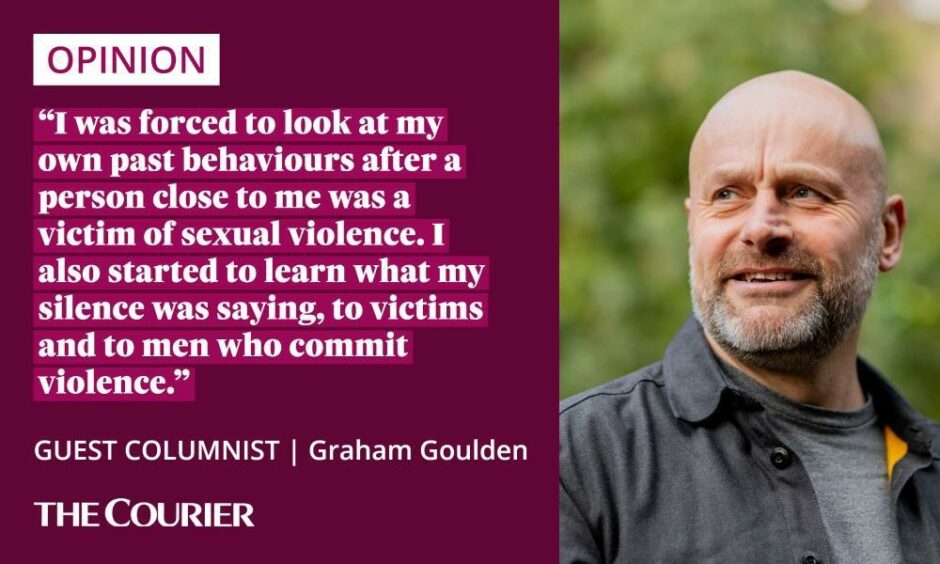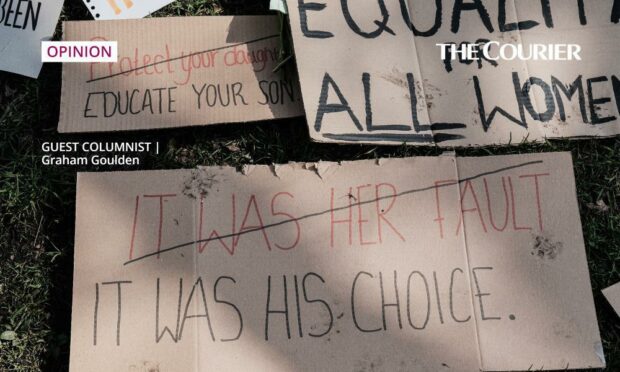Unless it can be proven that male infants are born hardwired for sexism, we must accept they are products of the environments they grow up and socialise in.
So if we are to drastically reduce levels of men’s violence against women and girls, we need to examine the environment in which we socialise boys and establish norms in male culture.
To achieve that will be challenging for men. There may be guilt about how they have objectified and disrespected women in the past.
To move these feelings into something more productive men need to move beyond defensiveness and ask themselves – how can I help change norms that are harmful to women and girls?

When I was asked to support the development of the recent ‘Don’t be that guy’ campaign with Police Scotland I was given the opportunity to shape the message.
The aim was to engage men as allies and to help make links between words and attitudes with acts of rape and sexual assault.
In the new BBC Radio4 Programme “Am I that guy” presenter and Courier columnist Alistair Heather deploys the honesty I describe above.
In doing so Alistair demonstrated his curiosity to learn more about a subject that is a badge of shame for men everywhere.
And before you describe me as some evangelical preacher, I’ve been where he has been.
Have you ever bought a woman dinner and felt she owed you something?
‘Am I That Guy?’ is a new @BBCRadio4 documentary about sexual entitlement. @graham_goulden, a consultant on Police Scotland’s viral ‘Don’t Be That Guy’ campaign, joins @Emmabarnett. https://t.co/XRajfVDVnV pic.twitter.com/JgvSaZdfsx
— BBC Woman's Hour (@BBCWomansHour) March 23, 2022
I was forced to look at my own past behaviours after a person close to me was a victim of sexual violence.
I started to see how they were impacting on others.
I also started to learn what my silence was saying, to victims and to men who commit violence.
Men’s silence on sexism is deafening to victims
Men’s silence is deafening to victims, and it says to abusers they have your support.
The standard you walk past is the standard you accept.
Alistair’s vulnerability and acceptance of his own past attitudes also appeared to shift to his good friends Sean Dillon and Allan Innes, AKA ‘Fermer’.
Both discussed their use of language and this reflection helped them to see their complicity in the bigger problem of men’s violence against women and girls.
I also spoke to Alistair, who asked me how men can talk to their friends when they use sexist language.
This doesn’t happen enough. Despite feeling uncomfortable, many men do nothing. It’s easier to tune out.
But research says we can equip men with both the moral courage and the tools to act.
I spent the last nine years of my policing career developing knowledge around this issue.
Now in my post-police years I continue to do this.
Tips for men on talking to friends
Most of us possess healthy views and attitudes which we can use to help us in these situations.
Shaming an individual isn’t helpful. It leads to confrontation and potentially a loss of a friendship.
This is a both a reachable and teachable moment… If we as men don’t step up, we fail girls and women, but we also fail boys and men
It’s why men often don’t act in these situations. But my wife, a social worker, uses a lovely phrase “Connect before Correct”.
I translated this into an effective way for friends to speak to friends.
Try saying something like: “Hey mate, you’re better than that (Connect), but that wasn’t right, and I could see she was scared of you (Correct)”.
Another option is for you to use your new knowledge alongside your past mistakes.
So try saying something like “I used to think like that, but I now know how it can make others feel. As a friend I just wanted to tell you that”.
Most guys don’t look in the mirror & see a problem. But it’s staring us in the face. Sexual violence begins long before you think it does. #DontBeThatGuy pic.twitter.com/78B05S5lRk
— Don't be That Guy (@ThatGuyScotland) October 13, 2021
When Alistair spoke to Fermer, he made it clear he didn’t support the language used, but he did it in a way that showed he respected his friend enough to tell him.
It’s now likely Fermer himself will reflect and share his thoughts with others in his social circle.
And it’s likely this approach will change Fermer’s views for the long-term.
It’s in these simple acts of vulnerability that change happens.
‘Friends don’t let friends make women feel unsafe’
This is a both a reachable and teachable moment for men.
If we as men don’t step up, we fail girls and women, but we also fail boys and men.
So, let’s come together. Be that guy who sees the issues and acts on them.
Men’s silence is the infection that allows violence to continue.
But real reductions in men’s violence against women and girls will take place when friends speak with friends.
Friends don’t let friends make women feel unsafe.
And all men have a clear role in creating a culture that not only supports girls and women but also one that supports the next generation of men.
Graham Goulden is a retired police officer of 30 years, including eight at Glasgow’s world-renowned Violence Reduction Unit. He now works to tackle men’s sexual violence.











